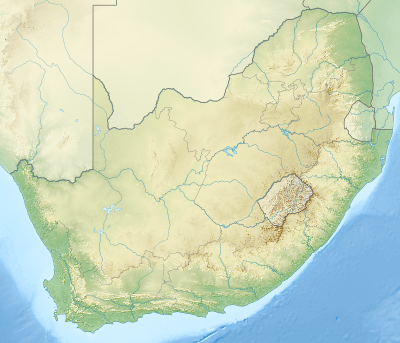Bontebok National Park
| Bontebok National Park | |
|---|---|
|
IUCN category II (national park) | |
|
| |
 Location of the park | |
| Location | Western Cape, South Africa |
| Nearest city | Swellendam |
| Coordinates | 34°04′S 20°27′E / 34.067°S 20.450°ECoordinates: 34°04′S 20°27′E / 34.067°S 20.450°E |
| Area | 27.86 km2 (10.76 sq mi) |
| Established | 1931 |
| Governing body | South African National Parks |
| http://www.sanparks.org/parks/bontebok/ | |
Bontebok National Park is a species-specific national park in South Africa. It was established in 1931 to ensure the preservation of the Bontebok. It is the smallest of South Africa's 20 National Parks,[1] covering an area of 27.86 km2[2] The park is part of the Cape Floristic Region, which is a World Heritage Site.[1]
The park is located 6 km south of Swellendam,[3] in the foothills of the Langeberg Mountains.[2] It is bordered to the south by the Breede River.[1]
The bontebok
Bonteboks are rare, unusually marked antelopes. They are listed as vulnerable in Appendix II of the International Trade in Endangered Species Red List. They are endemic to the Cape Floral area, and once roamed the region in large numbers. European settlement and hunting brought the animal to near extinction by the early 19th century. A relict population was protected on private farmland. In 1931, seventeen members of this population were translocated to the first Bontebok National Park. In the 1960s, half of the population died from worm infestations, copper deficiency and related syndromes. In 1961, 61 members of the surviving population were translocated to the current Bontebok National Park. The worldwide bontebok population of 2,500-3,000 individuals are all derived from this population.[4]
However, there are only about 200 bontebok in the park, as this is the maximum number a park of its size can support without inflicting serious damage to plant life. Over the years the park's surplus stock has been translocated to other nature reserves and private owners with suitable habitats.[2]
Other species found in the park
Conservation in the park include the protection of the endangered fynbos veld type and the coastal renosterveld, one of the largest remaining "renosterveld islands", which contains several plant species that are found nowhere else in the world.[1] In total, the park has nearly 500 grasses and other plant species.[3]
Other indigenous species in the park include the African clawless otter, Stanley's bustard, Secretary bird and the Blue crane, South Africa's national bird.[5] Grey Rhebok, Cape Grysbok, Duiker, Red Hartebeest and Cape Mountain Zebra can also be found here.[3] There are over 200 species of birds.[1]
-
Bontebok
-
Breede River in the park
-
Blue Crane
-
Breede River with Langeberge in the distance.
References
- 1 2 3 4 5 South African National Parks. park "Bontebok National Park" Check
|url=value (help). Retrieved 2006-08-13. - 1 2 3 South Africa Nature Reserves. "Bontebok National Park" (PDF). Archived from the original (PDF) on 2006-10-07. Retrieved 2006-08-13.
- 1 2 3 Lonely Planet Publications (2004-11-01). Lonely Planet South Africa, Lesotho and Swaziland. Lonely Planet. ISBN 1-74104-162-7.
- ↑ van der Walt, J.M.; L.H. Nel; A.R. Hoelzel (2001). "Characterization of major histocompatibility complex DRB diversity in the endemic South African antelope Damaliscus pygargus: a comparison in two subspecies with different demographic histories". Molecular Ecology. Blackwell Science. 10 (7): 1679–1688. doi:10.1046/j.0962-1083.2001.01321.x. PMID 11472536.
- ↑ Riley, Laura; William Riley (2005-01-03). Nature's Strongholds. Princeton University Press. ISBN 0-691-12219-9.
External links
| Wikivoyage has a travel guide for Bontebok National Park. |